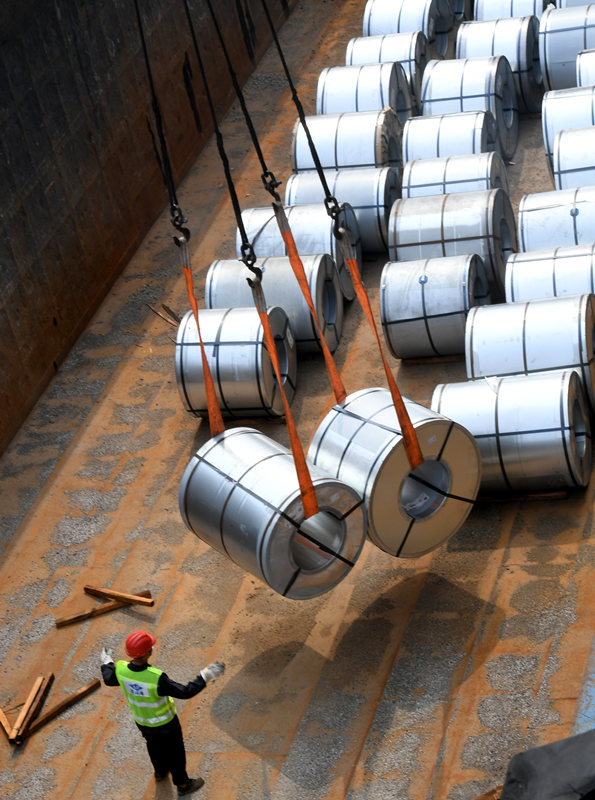A-share listed companies' scores in H1 diversify
By GT staff reporters Source: Global Times Published: 2020/9/1 18:18:40
China's farming and electronics stocks rise as economy recovers

Goods are being moved at a dock of the Huashan Port in the Pilot Free Trade Zone of Wuhan, Central China's Hubei province, which resumed full production on March 23, 2020. Photo: VCG
Driven by economic recovery and resilient consumer spending, several sectors including stock farming and electronics are making strong gains in the second quarter this year, despite an overall negative growth in the stock market, according to statistics from the companies listed in the A share market.
Recovery pushes up farming sector
The farming sector, including stock farming and agriculture, reported a 217.63 percent growth year-on-year, far exceeding any other sector in the market, according to data from Wind.
The increase in valuation is largely driven by the soaring price of the swine herds. Muyuan Food Company, a leading pig farming company in China, reported a staggering 7,026.08 percent jump in its net profit in the second quarter compared to the same period last year.
New Hope Group, another food company specializing in farming and animal products, also saw its net profit rise by 102.57 percent to 3.164 billion yuan ($463.83 million), according to a company report.
On Tuesday, the company said it plans to further lift its production target for the next few years, aiming for 40 million swine by 2022.
According to Dong Dengxin, director of the Finance and Securities Institute at the Wuhan University of Science and Technology, apart from the short-term element including this year's soaring pork price and rising demand for medical equipment, fast economic recovery and resilient spending power are also driving up the stock market.
"In the second quarter of this year, pork demand in China has been soaring as restaurants and the catering businesses reopen and people start to dine out as usual," Dong said, "The demand has pushed up the pork price as well."
Other companies that have witnessed exponential growth in the second quarter include electronics, medicines and food and beverages, all of which see a growth of more than 5 percent. Notably, companies that make personal protection equipment grew significantly in valuation.
According to company reports, Intco Medical, a company based in East China's Shandong Province, saw its net profit spike more than 2,600 percent in the first half of this year, reaching 1.921 billion yuan.
The overall picture of the stock market is still optimistic, and further expansion of commercial activities will help the growth of the sectors continue into the second half of this year, Dong said.
According to statistics from Wind, although for the second quarter the A share market companies' growth is still negative, it has significantly narrowed compared to the first quarter. All A-share companies show a growth of negative 13.06 percent, improving significantly from last quarter's negative 23.92 percent.
"For manufacturing companies, continued recovery of domestic and international orders will encourage more manufacturing activities, driving up confidence and valuation of smaller companies," Dong added.
Pressure persists for H2 stock market
Despite the recovery in economy, Dong noted that for the second half of this year, many companies will have to prove their worthiness through strong performance, as some companies' valuation for the first half of this year could be inflated by short-term investor optimism.
"The second half of 2020 will be a time of competition and will sift out a lot of underperforming companies," Dong said.
In the first half of 2020, some of the worst performing companies are facing a final fatal blow from the COVID-19. Baofeng Group, an online video service provider in China, failed to provide a half year report due to difficult operation and high risks in the company.
Listed in 2015, the company has been struggling for years over its declining profit rate since 2018. Its valuation has shrunken to 488 million yuan from its peak at over 40 billion yuan.
Among the most heavily hit companies during the first half of 2020, energy giants including PetroChina and Sinopec reported the grimmest result from all A-share listed companies.
According to company reports, PetroChina's revenue dropped 22.3 percent year-on-year to 929 billion yuan, and its net profit has also slumped to negative. Sinopec's revenue also dropped 31 percent in the first half of 2020, compared to last year.
The energy giants' loss was largely due to the plunging oil price in the first half of 2020, as the outbreak of COVID-19 has wiped out most of the usual demand for passenger flights and other vehicles that run on oil.
In the second half of this year, the two companies as well as the energy industry might be able to rebound as oil price climbs up, lifting pressure on production and sales, Dong said.
Figuratively speaking:
In H1, the operating income of 3,973 A-share listed companies that have disclosed financial results totaled 23.52 trillion yuan ($3.45 trillion), down 2.65 percent year-on-year, with net profit reaching 1.85 trillion yuan, down 18.24 percent on a yearly basis.
A total of 3,198 companies, or 80.49 percent, made a profit in H1.
Net profits of 1,714 companies, or 43.14 percent, saw a positive annual growth and that of 486 companies, or 12.23 percent, doubled year-on-year.
In Q2, revenue growth rate of A-share listed companies stood at 2.67 percent, up from -8.76 percent in Q1.
All 165 listed companies on the STAR market have released mid-year financial reports. Among them, the net profit of 104 companies, or 63.03 percent, increased year-on-year in H1, while that of 61 companies, or 36.97 percent, decreased year-on-year.